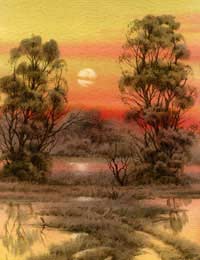Creating Expression

Long before the Expressionists (see related article) began to consider the communication of inner feelings to be of primary importance in painting great painters have always had a knack for evoking expression in their subjects, whether they be portraits or landscapes.
J.M.W Turner (1755-1851) was an expert at evoking the sensation of being in a storm, and how that reflected on the senses, whilst Caspar David Freidrich (1744-1840) brilliantly evoked the loneliness of the landscape.
In portraiture Francisca Goya, Rembrandt and Velazquez all expertly manipulated the nuances of facial and bodily expression in order to create empathy between the viewer and the subject of the painting. This can be seen as the key to good portraiture, and is also the basis on which advertisers’ market campaigns, manipulating the expression and physicality of the model to appeal to the audience.
The evocation of expression is everywhere around us, in painting, in film, on T.V. and on the web and in print media. It is sometimes easy to forget that all these forms of expression are also readily seen in real life and that what the media offer up is a crass and simplified vision of human physicality and emotion, designed to sell products! Despite this, painting is a medium in which the nuance of expression can still be applied, and often is by artists such as Chuck Close (b.1940), John Currin (b.1962) and Stella Vine (b. 1969), albeit in way that also reflects on our slick media age (sometimes in an ironic way).
Communicating Expression
To observe and convey expression requires sensitivity on the part of the painter, together with a high degree of observation. Much expression (and perhaps the part most focused on in paintings of people) is conveyed though the face of the subject, especially on the repose on the eyes and mouth. Factors such as whether the subject is looking straight out of the picture, to the side, or straight down will tell you a lot about their personality. The pallor of the subject will also impact on how they are seen –a rosy subject will seem healthy (too rosy, and they will appear inebriated!) whilst a pale subject may appear ill or weary. There is some exception to this rule as in the Victorian age paleness signified wealth (as the wealthy spent little time out of doors).How open the bodily pose of the subject is will also impact on how the subject is interpreted, whilst how much flesh is exposed will inevitably sexualise the image to some extent. Hand gestures can be employed in group scenes to indicate greeting (see Courbet’s (1819-1877) ‘Bonjour Monsieur Courbet’) or hostility.
In landscape expression tends to be conveyed by flat planes of colour or gestural marks that communicate how we may feel in the presence of given climates, terrains and weather conditions. Melancholy is often conveyed by a night sky, as in ‘Starry Night’ by Van Gogh (1853-1890), passion through a stormy sky.


Re: Contextualising Your Work
Dear Mr Watson, I have been working relentlessly for 40 years through Art, writing, performance based expressions in theatre, dance,…
Re: How to Sell My Paintings and Drawings?
Hi , I would like say about my cousin that he live in Afghanistan and he is fabulous in art painting and doing job…
Re: How to Sell My Paintings and Drawings?
Amy - Your Question:Hi I have just left school and I love to draw I do pencil work and I would love to sell my…
Re: How to Sell My Paintings and Drawings?
Hi I have just left school and I love to draw I do pencil work and I would love to sell my drawing but I don't no how…
Re: How to Sell My Paintings and Drawings?
Hi, I have 3 drawings the information as follows: 1- Salvador Dali (Spanish Draftsman). Is 24x19 cm. 2- Pablo…
Re: Freeing Yourself Up
I love drawing so much and I will like to be one of the best artist in the world
Re: How to Sell My Paintings and Drawings?
anna-81 - Your Question:Hi, I need help how can I sale my paintings and drawings and I want to know if my work is…
Re: How to Sell My Paintings and Drawings?
Hi, i need help how can i sale my paintings and drawings and i want to know if my work is really good or not. I'm…
Re: How to Sell My Paintings and Drawings?
i want to sell my drawing give me the idea.
Re: How to Sell My Paintings and Drawings?
I am 15 years old and i would like to sell my pencil drawing